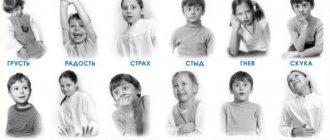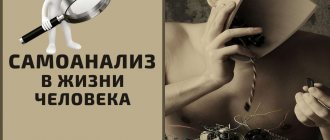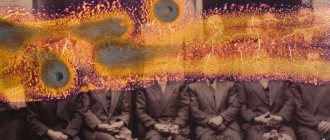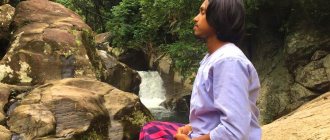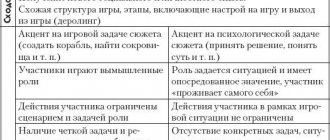What is reflection
This is reflectionReflection / New philosophical encyclopedia about your feelings, analysis of your own actions and their reasons through conversation with yourself.
You can evaluate both the past and the present. For the first time, ancient philosophers spoke about reflection and its importance. Today the term is used in psychology and pedagogy. Chinese court lady in contemplation and reflection. The authorship is attributed to the artist Gu Kaizhi. Image: Wikimedia Commons
The ability to reflect manifests itselfReflection / Large psychological dictionary at primary school age, and in adolescents, self-analysis occupies a central place in the choice of behavior and self-development. But adults don’t always find time for such thoughts.
Reflection as a human mental ability.
“Reflection” - turning back (from the Latin reflexio - the inner side of the bay,
facing the sea and reflecting its waves). This is the ability that allows a person to make his thoughts, emotional states, actions, relationships, himself the subject of special consideration (analysis and evaluation) and practical transformation (,). Developed reflection reveals to a person completely new possibilities in mastering his own behavior, gaining freedom from his own passions and external social pressure, and developing his author’s position in relation to his life.
There are several types of reflection depending on the place it occupies in the course of human activity: situational, retrospective and prospective. Situational reflection (reflection - in - action) ensures direct involvement in the situation, coordination and control of activities in accordance with the goal and changing conditions. Retrospective (reflection - after - action) allows you to analyze completed actions and past events to identify achievements and mistakes (in order to correct your behavior in the future). Perspective (reflection - before - action) makes it possible to carry out mental planning, select the most effective methods of implementation, predict the possible results and consequences of one’s actions. The Rook program most often uses retrospective reflection.
The subject of reflection can be a variety of areas of human existence: thinking, action, communication, values, orientation, qualities and personality traits. In general, information about what can be the subject of reflection in each specific case of life or in a specific developing situation of an activity is presented in Figure No. 8.
Figure No. 8. Direction of reflection.
It is difficult to imagine an exercise, a game, or even an entire activity that would require reflection in all the directions indicated above. Most often, one or two areas are identified that are fundamentally important for a given developmental situation, the integration of experience gained in an exercise (game, lesson). The direction of reflection is determined by the objectives of the exercise, its place in the overall structure of the lesson, and the purpose of the lesson as a whole.
Reflection is a process that has not only direction, but also depth. The first, superficial level is reflection of feelings. At this level, it is advisable to stop reflection only if the exercise or the entire lesson was specifically aimed at developing the ability to recognize one’s emotions and experiences. In all other cases, reflection of feelings is the triggering mechanism for further reflective work. Reflection on the result is important for exercises of a productive, design or creative nature, the result of which should be a product. Reflection of the process brings awareness to the applied methods of action, helps to understand the strengths and weaknesses of the chosen behavioral strategies. Reflection of values is the ultimate level of reflection, which allows you to see the meaning of what happened or is happening, to correlate your emotions, action, its result and process with your values. In general, a general idea of the existing levels of reflection is schematically presented in Figure No. 9.
Figure No. 9. Levels (depth) of reflection
Why is reflection useful?
Because this is how you can realize G. Di Stefano, G. P. Pisano, F. Gino, B. R. Staats. Making Experience Count: The Role of Reflection in Individual Learning / Harvard Business School Working Paper past mistakes and not making them again in the future. Reflection also gives you a chance to deal with real feelings and desires. Reflecting on the past, we are able to S. Ayan. 10 Things You Don't Know about Yourself / Scientific American understand the unconscious motives of your behavior and correct them. For example, find something you really like, instead of an activity imposed by someone.
Working on mistakes helps you become more effective. A Harvard Business School study found G. Di Stefano, G. P. Pisano, F. Gino, B. R. Staats. Making Experience Count: The Role of Reflection in Individual Learning / Harvard Business School Working Paper that reflective call center employees perform 23% better than those who do not reflect on themselves. The former quickly understood what was required of them and made decisions more confidently.
Finally, by listening to ourselves, we learn to listen to others, which helps us better understand our interlocutors and determine their feelings.
Interesting ways to conduct reflectionmaterial on the topic
Interesting ways to conduct reflection in primary school. (from the work experience of O.S. Gopanovich)
“He who has managed to reflect on reality receives advantages in moving forward” Evgeniy Domansky The concept of reflection. The priority goal of the modern educational concept has become the development of an individual ready for self-education, self-education and self-development. In this regard, one of the tasks of education is to develop in a child the ability to reflexively control his activities as a source of motive and ability to learn, cognitive interests and readiness for successful learning. The word reflection comes from the Latin reflexior - turning back. The Dictionary of Foreign Words defines reflection as reflection, self-control, self-knowledge. This is a form of theoretical human activity aimed at understanding his own actions and their laws. The explanatory dictionary of the Russian language interprets reflection as thinking about one’s internal state, introspection. In social psychology, reflection is the individual’s awareness of how he is perceived by his communication partner. And finally, in modern pedagogical science, reflection is usually understood as self-analysis of activity and its results. Reflection (from Latin reflexio - turning back) - students’ analysis of their own state, experiences, thoughts after completing an activity. This is an attempt to reflect what happened to my “I”: What did I think? How did you feel? What did you buy? What surprised me? What did I understand and how did I build my behavior? and so on. Reflection allows you to accustom the student to self-control, self-esteem, self-regulation and the formation of the habit of understanding events, problems, and life. Reflection contributes to the development of critical thinking in students, a conscious attitude towards their activities, as well as the formation of self-management.
Classification of reflection. 1. By content: • Oral reflection • Written reflection. 2. By purpose: • Reflection of emotional state • Reflection of activity • Reflection of content. 3. By function: • personal reflection (physical, spiritual, sensory) • intellectual reflection. 4. By type of lesson: • After mastering the zun • Intermediate reflection • Control reflection • Final reflection. 5.By methods of conducting: • Questionnaire • Question • Symbol • Table • Situation • Drawing. 5. By form of activity: • Frontal (selective) • Individual • Group • Collective
Functions of reflection in the pedagogical process:
1. Diagnostic 2. Design 3. Organizational 4. Communication 5. Meaning-creating 6. Motivational 7. Corrective.
The more a person knows about what has already been done, the more able he is to understand what needs to be done next. B. Disraeli
Stages of teaching reflection
Stage 1 – analysis of your mood, analysis of your successes Stage 2 – analysis of the work of classmates Stage 3 – analysis of the group’s work
Recommendations.
Reflection associated with the subject’s exploration of himself, the result of which is a rethinking of himself and his relationships, is called personal. Such reflection reflects the human essence: physical (had time - didn’t have time, easy - hard), sensory (well-being: comfortable - uncomfortable, interesting - boring), intellectual (what I understood, what I realized - what I didn’t understand, what difficulties I experienced), spiritual ( became better or worse, created or destroyed himself and others).
It should be borne in mind that spiritual reflection allows only a written, individual form of verification without publicizing the results.
Conducting reflection on mood and emotional state is advisable at the beginning of the lesson in order to establish emotional contact with the group and at the end of the activity.
Reflection on activity makes it possible to comprehend the ways and techniques of working with educational material and searching for the most rational techniques. This type of reflection is acceptable at the stage of checking homework and defending project work. The use of this reflection at the end of the lesson makes it possible to evaluate the activity of everyone at different stages of the lesson.
Reflection on the content of educational material is used to identify the level of awareness of the content of the material covered. It is effective to use an unfinished sentence, thesis, selection of an aphorism, assessment of the “increment” of knowledge and achievement of goals.
Reflection techniques. Reflection of activity. • What impressed you the most? • Will the knowledge acquired in this lesson be useful to you in later life? • What new did you learn in the lesson? • Think about what you need to change to work better? * What am I doing? * why am I doing this? * how do I do? * what new did I learn? * how did I find out? * what have I learned?
“Sun” A circle from the sun is attached to the board, rays of yellow and blue colors are distributed to the children. The rays need to be attached to the sun: yellow - I really liked the lesson, we received a lot of interesting information; blue - the activity was not interesting, there was no useful information.
“Apple tree” An apple tree is drawn on the board. Children are given drawn apples of two colors - red and green. They glue apples onto the apple tree: green - I think I did everything perfectly, I’m in a good mood; red - I didn’t cope with the task, I’m in a sad mood.
“Target” Children fill out a “reflective target” on the board, evaluating 1. their own activities 2. the teacher’s activities 3. the students’ activities.
“Tree of Predictions” The rules of work are as follows: the trunk of the tree is the topic, type of activity, the branches are statements that are carried out in the directions - “yes” and “no” (the number of “branches” is not limited), and the “leaves” are the rationale for these statements ( arguments in favor of this or that opinion, names, assessments, results, etc.)
“Thermometer” Using such a symbol, you can determine the state of emotions, the novelty of the material, lesson, originality, etc.
"Apple and Arrows"
“Levels” Using this symbol, you can determine at what level the students completed the tasks, what level their self-esteem corresponds to, etc.
“Peak of Mutual Understanding” The mood is depicted as a step. The first one is an extremely bad mood. The second is bad. The third is good. Fourth - I am confident in my abilities. Fifth – excellent. At the end of the lesson, the day, the student puts himself on the level of what his mood is.
“Stars” On “star” symbols, students write down their personal achievements in a lesson, for a week, a quarter, etc. and attach them to a diary, on a stand, on a board, etc.
“Basket of ideas” Students write down their opinions about the lesson on pieces of paper, all the pieces of paper are placed in a basket (box, bag), then the teacher selectively reads out the opinions and discusses the answers. Students express their opinions on pieces of paper anonymously.
“Faces” Reflection on the emotional state, can be used at various stages of the lesson. Students draw “faces” that match their mood or choose from the available ones.
“Sunny” Reflection on the emotional state, can be used at various stages of the lesson. Students are asked to choose a sun that matches their mood.
“Tree” Students write down their opinion about the lesson on paper in the shape of tree leaves, you can propose a series of questions, then attach them to the blank tree on the poster.
“Traffic light” At the beginning of the lesson, students choose one of the colors: red, yellow or green. After a lesson or completed work, the children must express their opinion on the issue of color. Red – no (what you didn’t like, mistakes), yellow – not really (doubts, difficulties) and green – yes (what you liked, what worked).
“Pyaterochka - 1” Students are asked to circle their hand on a piece of paper. Each finger is some kind of position on which you need to express your opinion. The thumb is important and interesting for me; Index finger - it was difficult for me (I didn’t like it); Medium – wasn’t enough for me; The ring finger is my mood; Pinky - my suggestions.
“Pyaterochka - 2“ In order for students to evaluate their activity and the quality of their work in the lesson, I suggest that the children conditionally mark their answers on a piece of paper: “V” - answered at the request of the teacher, but the answer is not correct “W” - answered at the request of the teacher, the answer is correct " | " - answered on his own initiative, but the answer is not correct "+" - answered on his own initiative, the answer is correct "0" - did not answer. By discussing the results of their observations at the end of the lesson, students will be able to objectively assess their activity and quality of work.
“Elephant” Students are given a piece of paper to draw an elephant. The leaves are collected by the teacher for further analysis of the student’s work in the lesson. Students are then verbally given characteristics of the elements. Ears means a person listens carefully, perceives more by ear; eyes - looks carefully, perceives more visually; trunk - the knowledge you acquire; the head is thought processes; look at the relationship between the head and the body: a large head - the author of the drawing uses his head more; thin legs - uncertainty.
“Mood Map” At the end of the lesson, the children fill out cards of their emotional state, in which they note their well-being, indicate their attitude to the lesson, writing down what they liked (didn’t like) during the lesson.
“It’s in the Hat” Students pass the hat to each other, when the music or counting ends, the one who still has the hat in his hands analyzes his work in the lesson or gives a grade to those working at the blackboard and justifies it.
“Plus - minus - interesting” Reflection can be carried out orally at the board, where students selectively express their opinions at will; they can be divided into rows into “+”, “–”, “?” or individually in writing. This chart was created by Edward de Bono, M.D., Ph.D., University of Cambridge, a specialist in the development of practical thinking skills. This exercise allows the teacher to look at the lesson through the eyes of the students and analyze it in terms of value for each student. For students, the most important columns will be “P” and “I”, since they will contain reminders.
“+” “–” “?”
All facts that caused positive emotions are recorded in the “+” column. In the “–” column, students write down everything that is missing or remains unclear. In the “interesting” (?) column, students write down everything they would like to know more about, what interests them.
“Sinquain” This is a method of creative reflection that allows you to evaluate the studied concept, process or phenomenon in an artistic form. In this case, information is not only more actively perceived, but also systematized and evaluated. The word comes from the French “5”. This is a poem of 5 lines, which is built according to the rules: 1 line - topic or subject (one noun); Line 2 – description of the item (two adjectives); Line 3 – description of the action (three verbs); Line 4 – a phrase expressing an attitude towards the subject; Line 5 – a synonym that generalizes or expands the meaning of a topic or subject (one word).
“Key words” The “key words” of the lesson are attached to the board, using which you can come up with a story or arrange them in a certain sequence. For example words: assessment, task, neighbor, teacher, etc.
“Expert Commission” At the beginning of the lesson, experts are selected (students who did an excellent job on the test). They record the students’ activities (row, option) throughout the lesson. At the end of the lesson, experts analyze the activities of their students, indicate successes and mistakes, and give them grades.
“10 points” Rate the work in class on a 10-point scale from the position: “I” 0________10 “We” 0________10 “Business” 0________10
“Today’s lesson for me...” Students are given an individual card in which they need to underline phrases that characterize the student’s work in the lesson in three areas.
Lesson I'm in class Result 1. interesting 1. worked 1. understood the material 2. bored 2. rested 2. learned more than I knew 3. indifferent 3. helped others 3. didn’t understand
At the end of the lesson, you can give the children a short questionnaire that allows them to carry out self-analysis and give a qualitative and quantitative assessment of the lesson. Some points can be varied and supplemented, it depends on what elements of the lesson you pay special attention to. You can ask students to justify their answer. 1. I worked in the lesson 2. My work in the lesson I 3. The lesson seemed to me 4. For the lesson I 5. My mood 6. The lesson material was for me
7.Homework seems to me active / passive satisfied / not satisfied short / long not tired / tired became better / became worse understandable / incomprehensible useful / useless interesting / boring easy / difficult interesting / not interesting
“Tomorrow test” Taking an essay before a test or independent work, in order to identify students’ readiness, gaps in knowledge, and their experiences. For an essay, you can prepare questions in advance.
“Pantomime” Students must use pantomime to show the results of their work. For example, hands up - happy, head down - not happy, covering your face with your hands - indifferent. “Logbook” From (English Log) - a form of recording information using keywords, graphic models, short sentences and conclusions, questions. The parts of the “logbook” set by the teacher that will be filled out by students may include: key concepts of the topic, connections that the student can make, important questions.
“Two-part diary” In one column - the subject of reflection, in the other - comments. The diary is kept over a long period of time and allows the student to carry out more thoughtful reflection, tracking both the immediate process and comparing their actions over time. For example, tracking test results.
Work Result
“Written interview” A variant of group written reflection in the form of questions and answers from group members. This method allows you to conduct written reflection in a fairly short period of time for the purpose of mutual exchange of opinions.
“Compliment” In order to end the lesson on a positive note, you can use one of the options for the “Compliment” exercise (Compliment-praise, Compliment on business qualities, Compliment on feelings), in which students evaluate each other’s contribution to the lesson and thank each other and the teacher for lesson taught. This option for ending the lesson makes it possible to satisfy the need for recognition of the personal significance of everyone.
“Clusters” Identification of semantic units of text and graphic design. We draw a model of the solar system: a star, planets and their satellites. In the center there is a star - this is our lesson, around it there are planets - parts of the lesson or task, we connect them with a straight line to the star, each planet has its own satellites - the results of the work. Based on the finished cluster, you can see the whole picture of the lesson and draw appropriate conclusions. The star can be a topic, student work in groups, a test, or a teacher in a lesson. The results can be assessments, suggestions, difficulties, successes.
“Prohibition” technique This technique is used when students reduce their thoughts about themselves and current events to the phrases: “I can’t...”, “I don’t know how...”, “I won’t be able to...”. Students are prohibited from saying “I don’t...”, but are asked to express the same thought in other words: what is needed to make it happen; what funds would be necessary to have for...; what skills do I need for this; what additional information do I need for this, etc. In the implementation of this technique, the student’s passive behavior is transformed into directed reflection on his experience.
“Bouquet of mood” At the beginning of the lesson, the children are given paper flowers: blue and red. At the end of the lesson, the teacher says: “If you liked the lesson and learned something new, then attach a red flower to the vase, and if you didn’t like it, then a blue one.”
You can offer children a wider range of colors: red, yellow, blue. At the end of the lesson, collect the flowers in a basket or vase.
Emotionally - artistic reflection. Students are offered two paintings of a landscape. One picture is imbued with a sad, melancholy mood, the other – with a joyful, cheerful one. Students choose the picture that matches their mood.
Emotional – musical reflection. Students listen to fragments from two musical works (it is advisable to indicate the composer of the work). There is alarming music and calm, enthusiastic music. Students choose a piece of music that matches their mood.
"What are you feeling now?"
Students in grades 3 and 4 can evaluate not only their mood, but also their emotional state. And the questions “How are you feeling now? What emotions are you experiencing? They quickly become familiar and do not surprise the children. To help students make their statements, we offer a supporting outline, which also helps expand their vocabulary.
“Reflective screen” Usually at the end of the lesson there is a summary, a discussion of what we learned and how we worked - i.e. everyone evaluates their contribution to achieving the goals set at the beginning of the lesson, their activity, the effectiveness of the class, the fascination and usefulness of the chosen forms of work. The guys in a circle speak in one sentence, choosing the beginning of a phrase from the reflective screen on the board: 1. today I learned... 2. it was interesting... 3. it was difficult... 4. I completed the tasks... 5. I realized that... 6. now I can ... 7. I felt that... 8. I acquired... 9. I learned... 10. I succeeded... 11. I was able... 12. I will try... 13. I was surprised... 14. He gave me a lesson for life... 15. I wanted... Evaluate your feelings in phraseological terms: - porridge in the head - no kick in the tooth - bright head of the “Island” The guys choose which of the proposed islands they are on at the end of the lesson: the island of Satisfaction, the island of Sadness, the island of Knowledge, the island of Joy.
A.M.O. “Restaurant” Purpose: Find out and get feedback from students from the last lesson. Time: 5 min. for preparation; 1-3 min. each participant (for response). Number of students: All students Materials: large format sheet, markers, tape, colored cards
Conduct: The teacher invites the students to imagine that they spent today in a restaurant and now the restaurant director asks them to answer several questions: - I would eat more of this... - I liked it most... - I almost overcooked... - I overate... - Please, add... Participants write their answers on cards and stick them on a flip chart sheet, commenting.
Note: For the teacher, this stage is very important, because it allows you to find out what the children have learned well and what needs to be paid attention to in the next lesson. In addition, feedback from students allows the teacher to adjust the lesson for the future. At the end, the teacher summarizes the lesson, gives homework if necessary, and finally says good words to the children. This is how a lesson using AMO will go unnoticed, fun, but effectively, bringing satisfaction to both the teacher and students.
A.M.O. “Fly agaric” A circle is drawn on a sheet of paper, which is divided into sectors according to the number of stages of the lesson. Questions are written outside the circle. For example, with a general topic of discussion, the question is asked “How satisfied was I …” • with the delivery of content • the opportunity to ask questions • the psychological atmosphere in the group • distributed work and information materials • organization of recreation Before starting work, you are given the opportunity to indicate your assessment by sticking circles on sectors of the circle or drawing felt-tip pen. The greater the satisfaction, the closer to the center of the circle the icons are placed (association - hitting the target). The general appearance of the “fly agaric” reveals the main trends in assessing work in its individual aspects. Next, a general discussion of the results is carried out with clarification of individual points. Note: This method is vulnerable because many tend to join the estimates of their predecessors. Therefore, you need to make sure that the placement of icons in a circle does not take place in front of all participants, but, for example, on a stand turned backwards.
A.M.O. "Hims"
Purpose: Find out and get feedback from students from the last lesson. Time: 15 min. Number of students: All students Material: large format sheet, felt-tip pens. Conducting: This method helps to find out impressions of a lesson or seminar on the following issues:
• Good... • Interesting... • Interfering... • I'll take it with me...
Each participant must answer questions frankly, including questions about their well-being, which also affects the productivity of work in the lesson.
A.M.O. “Everything is in my hands” Goal: Find out and get feedback from students from the last lesson. Time: 5 min. for an explanation; 10-20min. for individual work; 15 minutes. to view the exhibition Number of students: All students Material: large format sheet, felt-tip pens. Conduct: Questions to check the results of work are indicated using fingers: • Thumb - I would like to work on this topic more; • Index – here I was given specific instructions; • Average – I didn’t like it here at all; • Nameless – psychological atmosphere; • Little finger – I missed it here. Participants draw their hand on a piece of paper, tracing an outline, write down questions next to each finger and write the answers to these questions inside the outline. Then the sheets are posted on the exhibition and all participants are given time to get acquainted with it before the general discussion.
A.M.O. “Cleaning the house” Purpose: To find out and receive feedback from students from the last lesson, each participant to determine what was useful and what was useless. Time: 15 min. Number of students: All students Materials: three large format sheets with drawings, felt-tip pens. Carrying out: Three large sheets of paper are attached to the wall; the first one shows a suitcase, the second one shows a trash can, and the third one shows a meat grinder. Each participant receives three colored pieces of paper. On the “suitcase” the participant writes what he took away from the lesson or seminar, will take with him and will actively use. On the second sheet is what turned out to be useless, unnecessary and what can be sent to the trash. On the third sheet is what turned out to be interesting, but is not yet ready for use, what still needs to be thought out and finalized.
Literature 1. Abramov A., Bim-Bad, B., Gromyko, Yu. What is a basic component [Text] / A. Abramov, B. Bim-Bad, Yu. Gromyko // Teacher’s newspaper. – 1988. – December 17 . (No. 149).– P. 2. 2. Alekseev N.G. The ability to reflect as an essential component of the intellectual culture of a modern specialist [Text] / N.G. Alekseev // Problems and methods of forming the intellectual culture of a specialist. – Novosibirsk, 1984. – P. 100-102. 3. Bogin V.G. Several aspects of the problem of school education and some thoughts on ways to solve it / V.G. Bogin // Questions of methodology. – 1999.– No. 1-2. –C. 35-54. 4. Bogin V.G. Teaching reflection as a way to form a creative personality [Text] / V.G. Bogin // Modern didactics: theory - practice / ed. AND I. Lerner, I.K. Zhuravleva. - M., 1993.. 5. Kraevsky V.V., Khutorskoy A.V. Subject and general subject in educational standards [Text] / V.V. Kraevsky, A.V. Khutorskoy // Pedagogy. – 2003. – No. 2. – P. 3-10. 6. Kuzmina N.V. Teacher’s pedagogical skill as a factor in the development of students’ abilities [Text] / N.V. Kuzmina // Questions of psychology. – 1984. – No. 1. – P. 20-26. 7. Theoretical foundations of the content of general secondary education [Text] / ed. V.V. Kraevsky, I.Ya. Lerner. – M., Pedagogy, 1983. – P. 352. 8. Khutorskoy A.V. Activity as the content of education [Text] / A.V. Khutorskoy // Public education. – 2003. – No. 8 – P. 107-114. 9. Shchedrovitsky G.P. Selected works. [Text] / G.P. Shchedrovitsky – M.: School of Cultural Policy, 1995. – P. 133-138. 10. Shchedrovitsky G.P. Communication, activity, reflection. [Text] / G.P. Shchedrovitsky // Study of speech and mental activity. – Alma-Ata, 1974 11. Novichkov V.B. The eternal question: what to teach today? (Text) / V.B. Newcomers // Pedagogy. – 1988.-No. 8. –P.6-8 12. Elkonin D.B. Selected psychological works. - M.: Pedagogika, 1989. p. 81. 13. Yasvin V.A. Psychological modeling of educational environments. Psychological journal.-2000.-No. 4. 14L.A. Mednikova “Reflective activity of a junior schoolchild” J-l Science and school practice No. 1, 2008
1. Website of the international magazine on critical thinking “Peremena” https://www.ct-net.net/ru/ 2. Festival of pedagogical ideas https://festival.1september.ru/ 3. Newspaper “First of September” https:/ /ps.1september.ru/ 4. Website “My University”
Goal: to increase the motivation of colleagues to master the reflective activities of students.
Tasks:
- Introduce colleagues to the concept of “reflection”.
- Give an idea of the classification of reflection.
- Show specific options for conducting reflection in the classroom.
- Create conditions for active interaction between the master class leader and master class participants.
Progress of the event
Preparation for the master class.
- Distribute cards of a cheerful and sad person to the participants.
- Distribute tables, green and yellow cards.
- Distribute pieces of paper and pencils for making a syncwine.
- Hello, dear colleagues! I am glad to welcome you to my master class.
– Show your mood with an appropriate card. (I show too)
The topic of my Master Class is “Techniques for student reflection in the classroom in elementary school.”
In front of you is a table recording your knowledge, please fill out the second column “I know” on this topic and set it aside.
My goal: Slide 2
To increase teachers' motivation to master students' reflective activities.
What is your goal? (answers)
Slide 3. One parable says: “Once upon a time there lived a wise man who knew everything.
One man wanted to prove that the sage does not know everything. Holding a butterfly in his palms, he asked: “Tell me, sage, which butterfly is in my hands: dead or alive?” And he himself thinks: “If the living one says, I will kill her; if the dead one says, I will release her.” The sage, after thinking, replied: “Everything is in your hands.” In our hands, so that the child feels loved Slide 4
necessary Slide 5
and most importantly, successful. Slide 6
Psychologists especially emphasize that the formation and development of spiritual life is associated, first of all, with reflection.
What is reflection?
Slide 7. Reflection is a person’s reflection aimed at analyzing himself (self-analysis) - his own states, his actions and past events. At the same time, the depth of reflection and self-analysis depends on the degree of education of a person, the development of moral sense and the level of self-control. Reflection, in a simplified definition, is “talking to oneself.” The word reflection comes from the Latin reflexio - turning back. The Dictionary of Foreign Words defines reflection as thinking about one’s internal state, self-knowledge. The explanatory dictionary of the Russian language interprets reflection as introspection. In modern pedagogy, reflection is understood as self-analysis of activities and their results.
A prerequisite for creating a developmental environment in the classroom is the reflection stage. It helps students formulate the results obtained, determine the goals of further work, and adjust their subsequent actions. Reflection is associated with the formation of personal, regulatory and communicative universal educational actions, with the technology of critical thinking.
When interacting with a student, the teacher uses, depending on the circumstances, one of the types of educational reflection, reflecting the four spheres of human essence: Slide 8.
- physical (had time - did not have time);
- sensory (feeling: comfortable – uncomfortable);
- intellectual (what I understood, what I realized - what I didn’t understand, what difficulties I experienced);
- spiritual (became better or worse, created or destroyed oneself and others).
Reflection happens: Slide 9
a) individual - the formation of real self-esteem (for which you can evaluate your work, a conversation with the child based on the results of self-esteem - why this or that level was chosen); b) group – emphasizing the value of the activities of each group member to achieve maximum results in solving the task. (“They would have been able to do it if .... (name) had not worked with us.” “What kind of help did ... (name) provide in the work”).
Traditionally, psychology distinguishes several types of reflection:
- Slide 10 Communicative - its object is ideas about the inner world of another person and the reasons for his actions. Here reflection acts as a mechanism for knowing another person.
- Slide 11. Personal - the object of cognition is the cognizing personality itself, its properties and qualities, behavioral characteristics, system of relationships with others.
- Slide 12. Intellectual - manifests itself in the process of solving various kinds of problems, in the ability to analyze various solutions, find more rational ones, and repeatedly return to the conditions of the problem.
Reflection can be carried out not only at the end of the lesson, as is commonly believed, but also at any stage. Reflection is aimed at understanding the path traveled, at collecting into a common treasury what was noticed, thought out, and understood by everyone. Her goal is not just to leave the lesson with a fixed result, but to build a chain of meaning, to compare her methods and methods with others.
Slide 13. Based on the functions of reflection, the following classification is proposed.
- Reflection of mood and emotional state
- Reflection of activity
- Reflection on the content of educational material
Techniques for reflecting emotional states.
- Slide 14 Cards with a face (sad, happy); showing thumbs up or down.
- Slide 14 “Sunny” - I succeeded in everything, “sun and cloud” - I didn’t succeed in everything, “cloud” - I didn’t succeed.
- Slide 15 “Joyful gnome” - everything is fine, “sad gnome” - sad.
Reflection of activity. This type is acceptable at the stage of checking homework, defending design work; it makes it possible to understand the ways and techniques of working with educational material, to search for the most rational methods, and application at the end of the lesson will show the activity of each student.
- Slide 16 “Ladder of success” - the bottom step, the “little man” has his hands down - nothing worked out for me; middle step, the “little man” has his arms spread to the sides - I had problems; the top step, the “little man” has his hands raised up - I succeeded.
- “Dress up the Christmas tree” - successfully completed the task - hung the ball, there were mistakes - the ball remained near the tree.
- Slide 17 “Tree of Success” – green leaf – no errors, yellow leaf – 1 mistake, red leaf – 2-3 mistakes.
- Slide 18 “Train” On the board there is a train with trailers on which the stages of the lesson are indicated. Children are asked to put the “cheerful face” in the trailer that indicates the task that was interesting to complete, and the “sad face” in the one that symbolizes the task that seemed uninteresting. Only one token may be used at the discretion of the student.
- Slide 19 “Glade”. On the board there is a clearing of flowers, above each flower there is a stage of the lesson (working with text, phonetic exercises, etc.). There is a butterfly in front of every child. You invite the children to attach their butterfly to the flower which activity they liked best.
Reflection on the content of educational material is used to identify the level of awareness of the content covered.
Usually at the end of the lesson there is a summary, a discussion of what we learned and how we worked - i.e. everyone evaluates their contribution to achieving the goals set at the beginning of the lesson, their activity, the effectiveness of the class, the fascination and usefulness of the chosen forms of work. The guys in a circle speak in one sentence, choosing the beginning of a phrase from the reflective screen on the board: Slide 20
- today I found out...
- it was interesting…
- it was difficult…
- I completed tasks...
- I realized that...
- Now I can…
- I felt that...
- I purchased...
- I learned…
- I managed …
- I was able...
- I will try…
- I was surprised...
- gave me a lesson for life...
- I wanted…
Slide 21 “Plus-minus-interesting.” (author Edward de Bono, MD, PhD, University of Cambridge, specialist in the development of practical skills in the field of thinking)
Purpose: summing up the lesson. (This exercise allows the teacher to look at the lesson through the eyes of the students, analyze it from the point of view of value for each student.)
This exercise can be done either orally or in writing, depending on time availability. For written completion, it is proposed to fill out a table of three columns.
In the “P” - “plus” column, everything that you liked during the lesson, information and forms of work that aroused positive emotions, or in the student’s opinion may be useful to him in achieving some goals, is written down.
In the “M” - “minus” column, everything that was not liked in the lesson, seemed boring, caused hostility, remained incomprehensible, or information that, in the student’s opinion, turned out to be unnecessary for him, useless from the point of view of solving life situations, is written down.
In the “I” - “interesting” column, students write down all the interesting facts that they learned about in class and what else they would like to know about this problem, questions for the teacher.
Slide 22 An interesting technique of reflection is in the form of a syncwine (pentament). Cinquain was developed by the American poet Adelaide Crapsey, influenced by Japanese haiku and tanka miniatures. In Russia it began to be used in 1997. Can be used as a final assignment on the material covered.
- first line – topic name (one noun);
- the second is a description of the topic in a nutshell, two adjectives;
- the third is a line describing the action within this topic in three words;
- the fourth line is a four-word phrase that shows the attitude to the topic (a whole sentence);
- the last line is a synonym that repeats the essence of the topic.
In this conclusion, each student combines and generalizes his impressions, knowledge, and imagination.
Markings in the margins (insert, marking) - designation using signs in the margins near the text or in the text itself:
“+” – knew, “!” – new material (learned), “?” - I want to know
Cheat sheet - information, wording, rule, etc. in a compressed form. Drawing up memos, diagrams or texts for reference books.
Ranking, arrangement of concepts in the required order.
Restoration of a deformed statement, rule, text or addition of missing words (for example, when every third or fifth word is missing).
Slide 23 Tablet - recording knowledge and ignorance about a concept
| Concept | Knew | Found out | I want to know |
Slide 24 Cluster (bunch) – fixation of a system concept with interconnections.
The process of reflection must be multifaceted, since the assessment is carried out not only by the individual herself, but also by the people around her. Thus, reflection in the lesson is a joint activity of students and teachers, which makes it possible to improve the educational process, focusing on the personality of each student.
Slide 25. REFLECTION OF THE MASTER CLASS.
You have two cards: green and yellow. If you liked my master class: it was relevant, useful, interesting and you will use it in your work - show me the green card. Well, if all this doesn’t touch you at all, show the yellow card.
Take a card with a recording table, if you have something to add, write it in the third column. Who can read out their table data? (Answers from participants)
Work in groups. Compose a syncwine on the topic of the Master Class. Slide 22.
The syncwines are read out.
Thank you all very much!
Table for listeners.
| Concept | I know | Found out | I want to know |
| Reflection |
Sources:
- images.yandex.ru/?lr=53 Pictures
- it-n.ru ›attachment.aspx?id=105334
- A.V. Khutorskoy. Analysis, introspection and reflection of the lesson khutorskoy.ru/be/2008/0312/index.htm
- Golovkina Ekaterina Vyacheslavovna. Summing up the lessons. Reflection. ezhva-licey.ru/teachers/nmr/metodich_razrabotki/itogi_uroka/
- Gukalova Irina Viktorovna. The role and place of meaningful reflection in the classroom. kollegi.kz/publ/21-1-0-93
Share... I need to work on myself
Everything worked out for me today, I didn’t make any mistakes.
I can find solutions with the help of a teacher
When Reflection Becomes Too Much
Sometimes reflection can take up too much space in life and turn into soul-searching. In this case, a person devotes all his time to thinking about himself, his past, current situation and future. For example, he constantly replays situations from two years ago in his head, coming up with the ideal course of action.
Such reflection leads to 1. S. Nolen-Hoeksema, A. McBride, Larson, J. Rumination and psychological distress among bereaved partners / Journal of Personality and Social Psychology 2. J. J. Park, M. L. Millora. The Relevance of Reflection: An Empirical Examination of the Role of Reflection in Ethics of Caring, Leadership, and Psychological Well-Being / Journal of College Student Development to mental health decline. A possible reason is the wrong approach to self-analysis. For example, if a person constantly asks the question “why?”, then most likely there will be E. Watkins. Adaptive and maladaptive ruminative self‑focus during emotional processing / Behavior Research and Therapy concentrate on all problems at once. Such reflection is unlikely to make things better.
The result of prolonged soul-searching can be K. Toros, M. C. LaSala. Child protection workers' understanding of the meaning and value of self‑reflection in Estonia / Reflective Practice cyclical negative thoughts. They repeatedly force a person to experience pain, fear, despair and other unpleasant emotions. This condition can lead to long-term and severe depression.
How to learn to reflect
To prevent reflection from turning into soul-searching, you need to think about yourself correctly. Here's what you can do:
- Start small: you don't have to spend hours on self-analysis. Try G. Di Stefano, G. P. Pisano, F. Gino, B. R. Staats. Making Experience Count: The Role of Reflection in Individual Learning / Harvard Business School Working Paper start with 10–15 minutes. In general, this is already quite enough to feel the positive effects of reflection. You can gradually increase the time, the main thing is not to get too carried away.
- Think about something useful or good. For example, plan for tomorrow or remember today's successes. If you experience failure, reflect on what the situation taught you.
- Determine how it is more convenient for you to reflect. For example, you think best when you are walking in the park or lying with your eyes closed in silence. Or maybe it’s easier for you to keep a diary or talk to a psychologist. It doesn't really matter where you think. Reflection in a subway car on the way to work is no worse than introspection in a calm environment.
- Don’t get upset and don’t rush to give up everything if you can’t sit still or figure out what’s going on. It's normal when you don't know or understand something. The main thing is not to focus on whether you are reflecting correctly.
- Remember that your perception may not be completely objective. People tend to S. Ayan. 10 Things You Don't Know about Yourself / Scientific American See yourself better than you really are. Consider this when you think about your actions, and try to be honest with yourself. Only then will reflection be beneficial.
- Ask yourself the right questions. Instead of "why?" and “who is to blame?” It’s better to ask “what’s going on?” and “what options do I have?” This will help you really understand the problem and draw conclusions, rather than endlessly digest the consequences.
- Try to think about yourself from the outside, as if you were thinking about another person. Going beyond your “I” (mentally, without any mysticism) can help E. N. Carlson. Overcoming the Barriers to Self‑Knowledge: Mindfulness as a Path to Seeing Yourself as You Really Are / Perspectives on Psychological Science to better understand yourself. For example, this will allow J. S. Moser, A. Dougherty, W. I. Mattson et al. Third-person self-talk facilitates emotion regulation without engaging cognitive control: Converging evidence from ERP and fMRI / Scientific Reports you become less emotional about both your positive and negative qualities.
Techniques for developing reflection
Reflection is a formable ability. And its development occurs only if in the process of human activity situations are created that require stopping, going back, and analyzing what has been done. During classes, it is necessary to systematically create situations that trigger reflective thinking, and at the end of each lesson, allocate time for specially organized reflection. As techniques that promote the development of reflexive ability, the following can be used during classes:
Problematic situations when introducing a new concept, a new task for the group to determine the boundaries “I know - I don’t know”, “I can - I can’t”, the emphasis is on what needs to be learned and comprehended in order for ignorance to turn into knowledge. For example: “It turns out that I don’t know something and I can’t do something!” “I can figure this out if...” Tasks and games to examine a phenomenon or action from different positions or roles. For example, doubter, critic, expert, student, experimenter, manager, looking from the outside; "the one who wants..." Exercises with reflective stops “Stop and think!” (answers to the questions: “What are you doing?”, “How are you doing it?”, “Why?” and “Which point of the plan are we implementing now?”, etc.). Encouraging spontaneous reflective statements, paying attention to them (“I lost the thread of evidence...”, “And I did this and that and that and that...”, “Here everything is clear to me, but not here...”) Encouraging self-assessment of performance results (“Did you get exactly the results you expected? Why did it turn out differently?”) Imagination tasks “While listening to the text, try to imagine the events that are described in it.” Forecasting tasks: “What will happen next?”, “What is this text about (identifying the topic only by the title of the text)?” Using a tape recorder or video camera to record the activities of participants with subsequent analysis of what is happening.
